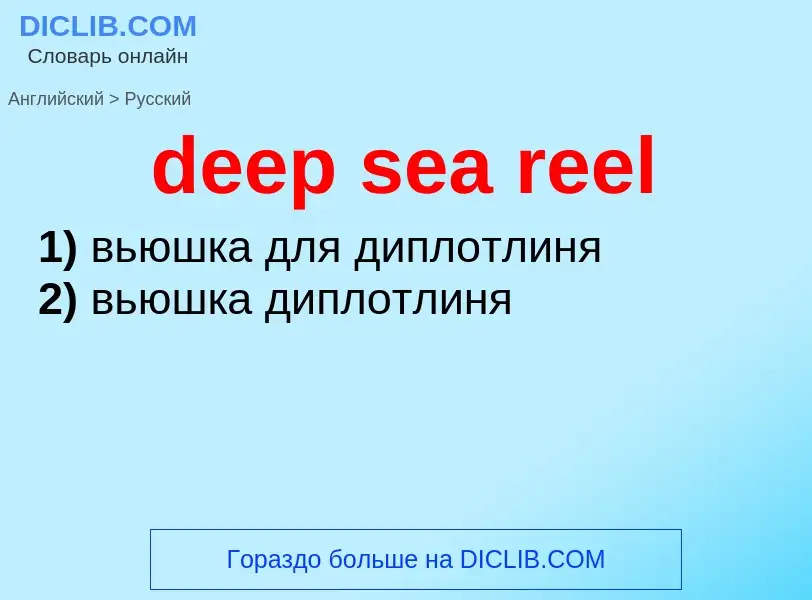Перевод и анализ слов искусственным интеллектом ChatGPT
На этой странице Вы можете получить подробный анализ слова или словосочетания, произведенный с помощью лучшей на сегодняшний день технологии искусственного интеллекта:
- как употребляется слово
- частота употребления
- используется оно чаще в устной или письменной речи
- варианты перевода слова
- примеры употребления (несколько фраз с переводом)
- этимология
deep sea reel - перевод на русский
['di:p'si:]
общая лексика
глубоководный
прилагательное
общая лексика
глубоководный
Смотрите также
нефтегазовая промышленность
глубоководная морская добыча
нефтегазовая промышленность
добыча под морским дном
общая лексика
шпульный
[ri:ltə'ri:l]
прилагательное
общая лексика
катушечный (о магнитофоне; в противоп. кассетному)
Определение
2) Эгейское море
Википедия

Deep-sea fish are fish that live in the darkness below the sunlit surface waters, that is below the epipelagic or photic zone of the sea. The lanternfish is, by far, the most common deep-sea fish. Other deep sea fishes include the flashlight fish, cookiecutter shark, bristlemouths, anglerfish, viperfish, and some species of eelpout.
Only about 2% of known marine species inhabit the pelagic environment. This means that they live in the water column as opposed to the benthic organisms that live in or on the sea floor. Deep-sea organisms generally inhabit bathypelagic (1000–4000 m deep) and abyssopelagic (4000–6000 m deep) zones. However, characteristics of deep-sea organisms, such as bioluminescence can be seen in the mesopelagic (200–1000 m deep) zone as well. The mesopelagic zone is the disphotic zone, meaning light there is minimal but still measurable. The oxygen minimum layer exists somewhere between a depth of 700 m and 1000 m deep depending on the place in the ocean. This area is also where nutrients are most abundant. The bathypelagic and abyssopelagic zones are aphotic, meaning that no light penetrates this area of the ocean. These zones make up about 75% of the inhabitable ocean space.
The epipelagic zone (0–200 m) is the area where light penetrates the water and photosynthesis occurs. This is also known as the photic zone. Because this typically extends only a few hundred meters below the water, the deep sea, about 90% of the ocean volume, is in darkness. The deep sea is also an extremely hostile environment, with temperatures that rarely exceed 3 °C (37 °F) and fall as low as −1.8 °C (29 °F) (with the exception of hydrothermal vent ecosystems that can exceed 350 °C, or 662 °F), low oxygen levels, and pressures between 20 and 1000 atm (between 2 and 100 MPa).



![The rattail ''[[Coryphaenoides armatus]]'' (abyssal grenadier) on the Davidson Seamount at 2253 m depth. The rattail ''[[Coryphaenoides armatus]]'' (abyssal grenadier) on the Davidson Seamount at 2253 m depth.](https://commons.wikimedia.org/wiki/Special:FilePath/Coryphaenoides armatus 1.jpg?width=200)

![[[Gigantactis]] is a deep-sea fish with a [[dorsal fin]] whose first filament has become very long and is tipped with a bioluminescent [[photophore]] lure. [[Gigantactis]] is a deep-sea fish with a [[dorsal fin]] whose first filament has become very long and is tipped with a bioluminescent [[photophore]] lure.](https://commons.wikimedia.org/wiki/Special:FilePath/Gigantactis.jpg?width=200)
![An annotated diagram of the basic external features of an [[abyssal grenadier]] and standard length measurements. An annotated diagram of the basic external features of an [[abyssal grenadier]] and standard length measurements.](https://commons.wikimedia.org/wiki/Special:FilePath/Grenadier basic external features.png?width=200)
![[[Pelican eel]] [[Pelican eel]]](https://commons.wikimedia.org/wiki/Special:FilePath/PSM V23 D086 The deep sea fish eurypharynx pelecanoides.jpg?width=200)
![[[Bigeye tuna]] cruise the epipelagic zone at night and the mesopelagic zone during the day [[Bigeye tuna]] cruise the epipelagic zone at night and the mesopelagic zone during the day](https://commons.wikimedia.org/wiki/Special:FilePath/Thobe u0.gif?width=200)



![The [[pelican eel]] uses its large mouth like a net by opening its jaws and swimming towards prey. It has a luminescent organ at the tip of its tail to attract prey. The [[pelican eel]] uses its large mouth like a net by opening its jaws and swimming towards prey. It has a luminescent organ at the tip of its tail to attract prey.](https://commons.wikimedia.org/wiki/Special:FilePath/Eurypharynx pelecanoides.jpg?width=200)

![Female ''[[Haplophryne mollis]]'' anglerfish trailing attached males which have atrophied into a pair of gonads, for use when the female is ready to spawn. Female ''[[Haplophryne mollis]]'' anglerfish trailing attached males which have atrophied into a pair of gonads, for use when the female is ready to spawn.](https://commons.wikimedia.org/wiki/Special:FilePath/Hamol u0.gif?width=200)


![[[Scallop dredge]] catch}} [[Scallop dredge]] catch}}](https://commons.wikimedia.org/wiki/Special:FilePath/Scallop dredge catch.jpg?width=200)
.png?width=200)




![[[Magnetophon]] from a German radio station in World War II. [[Magnetophon]] from a German radio station in World War II.](https://commons.wikimedia.org/wiki/Special:FilePath/Ton S.b, tape unit.jpg?width=200)
![Polish]]-made reel-to-reel tape recorder Polish]]-made reel-to-reel tape recorder](https://commons.wikimedia.org/wiki/Special:FilePath/Unitra ZK-147.jpg?width=200)
